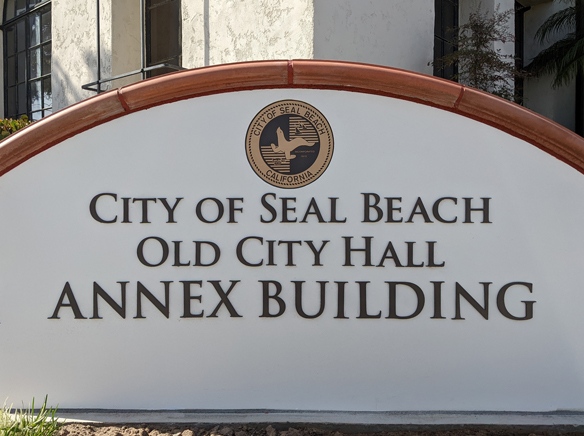Following a public hearing, the City Council on May 13 introduced a permanent amendment to the Main Street Specific Plan. The vote was 4 to 0. District Three Councilwoman Lisa Landau abstained.
If adopted on second reading (at a future meeting), the amendment would allow sidewalk uses for Main Street, including outdoor dining, subject to an administrative approval. The amendment allows permits to be revoked if outdoor areas are not maintained. The amendment will be implemented on July 1. Except for potted plants and benches, anything placed outside would have to be brought inside at closing time.
The original proposal did not include retail uses, but the council added retail use.
Council members discussed whether to require 8 feet of clearance for pedestrians or 6 feet. The council members decided on 8 feet for now.
The issue will come back to the council in six months for an update.
Hearing
Only two individuals spoke during the public hearing.
Rob McCone, who works on Main Street, said the Americans with Disabilities Act allowed a 4-foot clearance. McCone called for a 6-foot pedestrian clearance. He had made the same recommendation at the April 15 Planning Commission meeting.
Jim Watson also proposed a 6-foot clearance.
“Marina Café significantly increased their sales by 20 to 25% almost immediately after they had outside dining,” Watson said.
He said Marina Café had a 6-foot clearance, despite being the busiest corner in Old Town,” Watson said.
“We have not experienced any pedestrian problems with a. 6-foot clearance,” Watson said.
“The 6-foot clearance exists on all lots on Main Street,” Watson said.
“With an 8-foot restriction, you can now only seat two people,” Watson said.
Council discussion
Landau recused herself before staff presented the report.
“I will not be participating in the council’s consideration of the Main Street Specific Plan amendment, due to a potential conflict of interest involving one of my sources of income,” Landau said.
“The name of the source of income is Robert Griffith, who owns property on Main Street. I have requested advice from the Fair Political Practices Commission regarding this financial interest and its effect on my duties as a public official. In an abundance of caution, I am abstaining from this item because I have not yet received the FPPC’s advice,” Landau said.
(According to Schedule C of her FPPC Form 700, which she filed at 9:44 p.m., April 2, Landau received or had outstanding a loan from Griffith. Under “highest balance during reporting period” Landau checked off the box for “over $100,000. There is no larger amount on the form and no space on the form for a precise balance. The form is a public record.)
Landau then left the Council Chambers.
District One Council Member Joe Kalmick said based on the staff’s work, he would support the proposal. According to Kalmick, they had gone over every inch of Main Street. He said when an applicant came in, staff would know what can be allowed at that particular address.
“My only caveat is, we need to make sure that we enforce what is going to be allowed if this passes,” Kalmick said.
“Make sure that if a restaurant is allowed three, two-person tables, that they don’t wind up with four or six,” Kalmick said.
City Attorney Nicholas Ghirelli recommended holding a public hearing before the council made a decision.
District Four Council Member/Mayor Schelly Sustarsic opened the public hearing.
After McCone and Watson spoke, Sustarsic closed the hearing.
In response to a question from District Two Council Member Tom Moore, SealBeach Planning Manager Shaun Temple explained how staff arrived at an 8-foot clearance.
According to Temple, that during the conditional use permit hearing to allow 12 seats outside the Marina Café, there was a lot of public comment expressing concern with over-crowded sidewalks. Temple said the Planning Commission felt uncomfortable with too much area being occupied. “So that was reduced to 6 feet,” Temple said.
He said staff wanted to keep the scale small. He said 8 feet would allow the majority of restaurants to participate in the program.
Sustarsic thought it would be fair to allow retail sidewalk use. “It seems to me that they should be given an equal opportunity to do that,” Sustarsic said.
As to the clearance issue, Sustarsic said if you approve 6 feet and then decide on 8 feet, “It’s hard to go back.”
Community Development Director Alexa Smittle agreed. She suggested staff could bring the matter back to the council in the fall or in a year to give the council an update.
Sustarsic also asked about outdoor alcohol service.
According to Smittle, the outdoor use amendment was written to be compliant with the California Alcoholic Beverage Control Department.
If the ABC chose to waive the requirement for an outdoor partition, then the business could serve alcohol. If would be up to the applicant to approach the state agency.
District Five Councilman Nathan Steele said Main Street was a stroller’s street. People stroll one side and then the other. “The longer a wallet stays on Main Street, the more chances are that some dollars are going to fall out of that wallet,” Steele said.
He believed the amendment would be good for merchants. He said he would be fine with a 6-foot clearance. Steele suggested talking about 6 feet later on.
District Two Council Member Tom Moore said he agreed with Kalmick and Steele. He said it would create a nice atmosphere for the city. He would be OK with retail use and with 6 feet of clearance.
Kalmick asked if Main Street tree wells were more imposing on available space than other cities.
Apparently referring to the clearance space Temple said it was really a preference.
Kalmick said he would like to allow 6 feet so restaurants can place as many tables as they could. However, he expressed concern about the impact of tree wells on available space for foot traffic.
“I’m in favor of 6 feet if it works,” Kalmick said.
Public Works Director Iris Lee said staff felt 8 feet was complimentary to the area. She also suggested brining the clearance space back to the council in the future.
Sustarsic said she would like to start with an 8-foot clearance and see how it goes.
The accommodation for retail use of sidewalks was not included in the resolution that was brought to the council. However, staff had prepared language if the council had decided to include the retail uses that the Planning Commission proposed in April.
Temple read the language for the council members to consider a motion.
The council struck out the language that had prohibited retail outdoor uses for Main Street.
The motion included revoking permits for outdoor uses that are not maintained.
Moore requested a six-month update.
Sustarsic moved and Steele seconded the proposal.
Background
On April 15, the Planning Commission voted 4-1 to recommend the council approve the amendment to the Specific Plan. District Four Commissioner Patty Campbell cast the dissenting vote.
Later, Campbell said she voted no because people didn’t support the guidelines as written. (For details, see “Planners support Main Street Specific Plan amendment,” at sunnews.org.)
According to the staff report prepared by Planning Manager Temple, the Main Street Specific Plan was adopted in 1996.
“Like many communities, Seal Beach instituted an outdoor dining ‘parklet’ program during the pandemic, temporarily suspending MSSP regulations and allowing for outdoor dining in the public right-of-way, primarily in parking spaces,” Temple wrote.
The parklet program ended in 2023.
“The end of the parklet program was subject to significant community debate, and though the parklets were ultimately eliminated, the City Council expressed interest in exploring other options for Main Street to allow for outdoor dining,” Temple wrote.
“With the amendment as proposed, ground floor businesses would be able to enhance their storefronts with potted plants, A-frame signs, or small dining tables. Currently, these uses may be achieved in other ways, typically a Minor Use Permit that must be approved by the Planning Commission,” Temple wrote.





